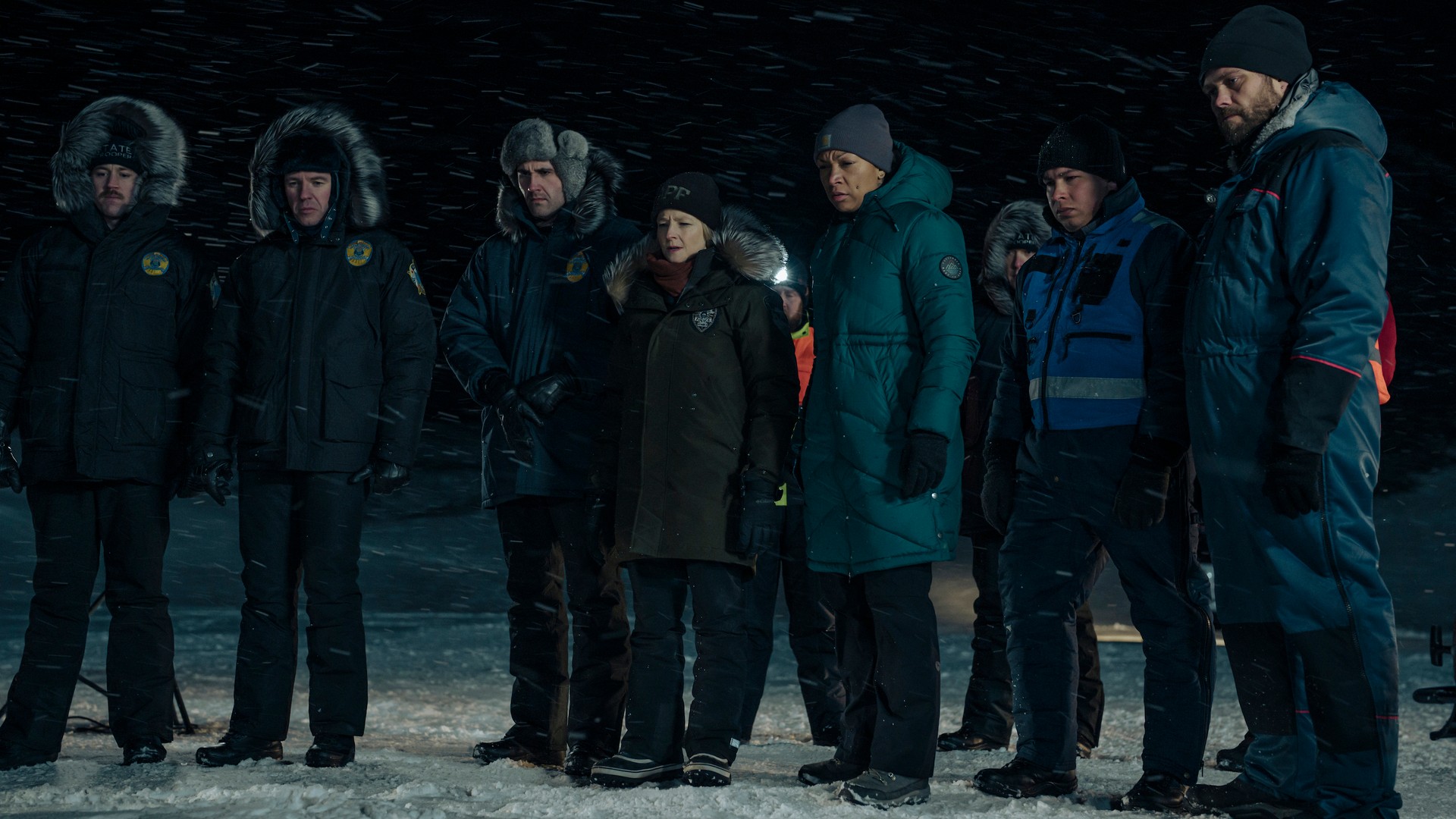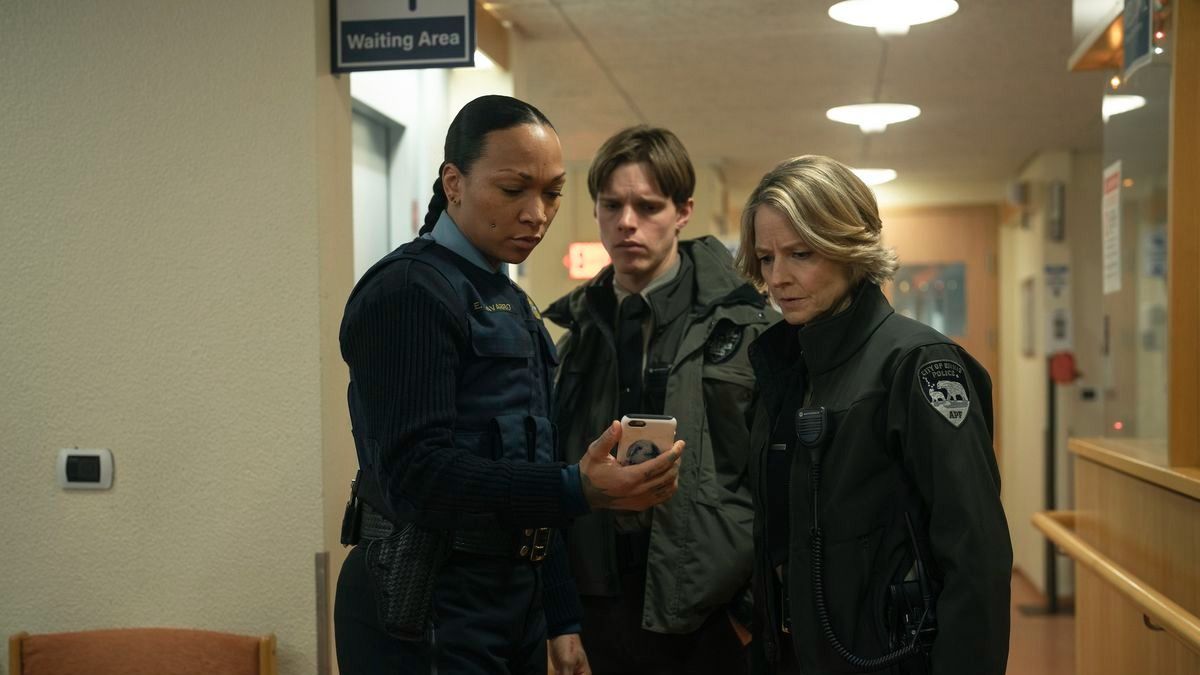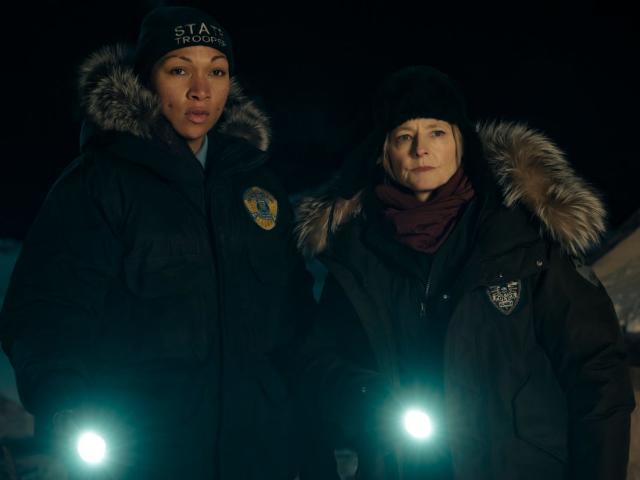There are two historical enigmas that overtly inspired True Detective season four, subtitled Night Country: that of the Mary Celeste, a 19th-century American ship whose entire crew seemed to evaporate into thin air while the vessel was on a voyage to Italy; and the 1959 Dyatlov Pass incident, a case involving nine Soviet hikers who inexplicably abandoned their campsite, then froze to death in the nearby wilderness. But even beyond those, showrunner Issa López has stocked her chilly saga with references to culture, history, and true crime that both reinforce the themes of Night Country and draw a straight line between it and True Detective’s rich past, particularly the show’s zeitgeist-grabbing 2014 first season.
Below, you’ll find the most tantalizing allusions and Easter eggs we could tease out of all six episodes of True Detective: Night Country.
PART 6
Into the Caves
Lest we forget, the final episode of True Detective season one also involved a literal descent into darkness—not into ice caves, but the ruined temple that murderous pedophile Errol Childress called “Carcosa.” What is Carcosa? For the answer, you’ve got to open a whole other can of worms.
Spirals, Spirals, Everywhere
So, what inspired the various spiral shapes that have been haunting this season, and True Detective more specifically? An ancient creature frozen into the ice, as seen above Raymond Clark’s science hole/murder cave. Now you know!
Down the Hatch
Is Issa López a Lost fan? Well, both her show and that mystery-box classic feature a mysterious polar bear—as well as a hatch in the ground that leads to a location devoted to even more mysterious scientific experimentation. Though in Night Country’s case, the real surprise isn’t where the hatch leads to—it’s where the hatch leads from. (In this case: the Tsalal Research Center.)
Mmmm, Funyuns
While stuck at Tsalal during the storm, Danvers chooses a snack we saw previously in episode one, when the station’s snack delivery man initially realized that something was amiss at Tsalal. I guess what they say is true…

…Time Is a Flat Circle
Clark is, of course, self-consciously echoing the most memorable line from season one, the Rust Cohle-est thing ever uttered by Rust Cohle. Though actually, those words are spoken first by murderous meth manufacturer Reggie Ledoux, right before Rust kills him: “You’ll do this again,” he predicts to the detective, whom Ledoux says he’s seen in his dreams. “Time is a flat circle.”
It’s a line so good that Nic Pizzolatto uses it again later in the episode, when Rust is giving false testimony to internal investigators about what really happened to Ledoux:
Why should I live in history? I don’t want to know anything anymore. This is a world where nothing is solved. Somebody once told me, “Time is a flat circle.” Everything we’ve ever done or will do, we’re gonna do over and over again… And that little girl and that little boy are gonna be in that room again and again, forever.
Internal Investigation
There’s a universe in which all of Night Country is framed around the testimony Danvers gives to internal investigators in the finale’s final moments—an attempt to learn what really happened to Hank that recalls the framing device of season one. Instead, season four chooses to use Danvers’s testimony to wrap up a few dangling plot threads—and to set up what may be next for Danvers and Navarro. (True Detective: Day Country, anyone?) In those closing moments, they both seem ready to agree with what Rust said at the end of season one: “Once, there was only dark. You ask me, light’s winning.”
PART 5
“So What’s the Use?”
The incredibly bleak song that Hank Prior sings as the protest at the mine turns violent isn’t just performed by John Hawkes—Hawkes tells VF that it was written by him too, in character as Hank. That might help explain why the lyrics are so unrelentingly bleak. (A sample: “There is no love/none lost none found/there is no god/no hallowed ground.”

An Avalanche?!
Forensics came back for the Tsalal case, Captain Connelly tells a skeptical Danvers in the office of the Silver Sky Mine. According to those findings, the scientists died not at the hands of a human murderer but because of Mother Nature: “It was a weather event. Slab avalanche. They’re sudden and can move at 100 miles an hour.” The theory, he explains, is that the scientists went outside to watch the last sundown of the year, then got caught in an avalanche and suffered hypothermia.
Danvers, of course, thinks this sounds like complete BS. She probably doesn’t think the hikers at the Dyatlov Pass died due to an avalanche, either—but there’s a whole bunch of scientists who disagree. In 2019, Russia officially reopened the case, hoping to find out what really happened on that fateful hike. In 2021, Nature published a paper explaining how a slab avalanche was likely responsible for the mysterious event: “how a combination of irregular topography, a cut made in the slope to install the tent and the subsequent deposition of snow induced by strong katabatic winds contributed after a suitable time to the slab release, which caused severe non-fatal injuries in agreement with the autopsy results.” Additional fieldwork has supported that hypothesis.
But Issa López doesn’t buy it. “An avalanche doesn’t explain a lot of the details,” she told me last fall. “Even if it did, I prefer the strange, incomplete answer. I think there is a fascination with puzzles that are still missing a couple of pieces and that obsess us and make us angry and make us not stop thinking about them.”
Again With the Spirals
According to Qaavik’s pal, those ever present spirals have another meaning in Ennis: They signify places where the ice is so thin that it can be cracked, leading to the intricate cave system below the surface. Those caves, by the way, are also known among locals as “night country.” It’s all coming together!
PART 4
Who’s Afraid of Virginia Woolf?
The most heartbreaking development in Night Country thus far comes when Navarro’s sister, Julia, succumbs to her mental illness, stripping off her clothes before solemnly walking out into a frozen sea. Her suicide evokes the deaths of the Tsalal scientists, but also the suicide of Virginia Woolf—particularly because Julia’s death follows her admission to a mental health facility called The Lighthouse. What’s more, when an injured Navarro stumbles into Qavvik’s house shortly after learning that her sister has drowned, we see him asleep in his chair, having dozed off while reading this edition of Edward Albee’s Who’s Afraid of Virginia Woolf.
Norlandair
Hank waits for his catfish bride to deplane a jet by this carrier, which is not Alaskan, but Icelandic—a nice nod to Night Country’s primary shooting location.
Otis Heiss
Speaking of names: “Heiss” means hot in German. Maybe that’s why this mysterious figure never really took to the frigid Night Country.
“We’re All in the Night Country Now”
Heiss’s exceedingly creepy, episode-ending proclamation makes one wonder if he might just be a personification of a certain demonic clown from Derry, Maine. We all float in the Night Country! Come with us, and you’ll float too!
PART 3
“I Wish I Was in Dixie Land”
Members of Hank Prior’s “hillbilly” gang drive a vehicle with a horn that plays this notorious Confederate anthem—which could be a reference to season one’s southern setting, or could just serve to reinforce the divide between him and the team of Danvers and Navarro.
Orange You Glad?
At the beginning of the episode, Navarro finds and pockets an orange dropped by one of the aforementioned hillbillies. Later, she throws it into the darkness, only for the fruit to roll right back to her. Anyone who’s seen The Godfather should know that this is not a good sign. In Francis Ford Coppola’s mob masterpiece, oranges are famously an indication of impending death or tragedy; Don Corleone buys a bag of them, for instance, right before an attempt on his life.
Funnily enough, the symbolism was apparently unintentional; Godfather production designer Dean Tavoularis apparently decorated the set with oranges simply because their bright color was a nice contrast to the film’s otherwise somber environs. But a film buff like López likely knows what she’s doing by having Navarro discover one on the tundra—and not just because an orange stands out starkly against the white ground.

The Evidence Room
There’s a big ol’ box labeled METH in the Ennis police department’s evidence room—and this might be a reach, but season one antagonist Reggie Ledoux was a meth peddler whose lab was the site of a climactic scene in episode 5.
The Wheeler Case
Much like Rust and Marty, Danvers and Navarro have been lying about a case in their past in which a suspect wound up dead. Years after that meth lab showdown, the original true detectives told investigators that they shot Ledoux in self defense. In reality, Marty shot the drug dealer point-blank after finding that he had imprisoned a pair of children.
Similarly, Danvers tells Peter Prior that in their last case as partners, she and Navarro arrived at the home of a known domestic abuser named William Wheeler to find that he had killed his wife, then killed himself. (The man shares his name with a 19th century vice president, though that’s likely a coincidence.) But in reality, we learn, Wheeler was still alive when Danvers and Navarro entered his house. So how did Wheeler actually die?
The Possession
When the horrifically injured Anders Lund sits bolt upright in his hospital bed and starts speaking directly and creepily to Navarro—“Your mother says hello. She’s waiting for you”—it’s hard not to be reminded of a whole host of horror-movie demons. The granddaddy of them all, of course, is The Exorcist, in which a different satanic being evokes his interlocutor’s mother in an incredibly disturbing way.
PART 2
Travis Cohle
Yes, you heard right: Fiona Shaw’s Rose was in fact romantically involved with Travis Cohle, father of Rust Cohle, who died sometime before our story began. We should have seen this coming. In True Detective season one, Rust claimed that his enigmatic dad raised him in Alaska. According to Rust, the elder Cohle knocked up Rust’s mother while on leave from the Army, went back to Vietnam, and returned when little Rust was two years old. “Then she hauled ass, and he and I moved to Alaska,” he continued. “He was a survivalist, I guess you’d call it. Had some very fucking strange ideas.” You’re telling us, pal.
Rust went on to explain that because he couldn’t handle the cold, as an adult, he headed back to his home state of Texas. “My old man always made like I let him down that way,” he said. “Said I had no loyalty.” And now we can see that Travis apparently loved Alaska so much that his ghost still resides there, even years after the elder Cohle’s death from leukemia.
“We Should Send This Thing Back to Anchorage”
Intentionally or not, when she floats the idea of bringing the corpsicle to a bigger city with more resources—before again claiming ownership over the Tsalal case—Danvers echoes one of the more memorable lines from Jodie Foster’s most intensely quotable movie: “Take this thing back to Baltimore!”
Follow the Money
After teasing the answer last week, Peter Prior revealed in episode two who’s really funding Tsalal: an NGO, run by a shell company called NC Global Strategies, which in turn belongs to a company called Tuttle United. What do they do, asks Danvers? Everything, says Peter: “Glass, tech, video games, shipments, palm oil, cruise lines…”
Danvers doesn’t think this information is helpful, but that must be because she didn’t watch True Detective season one. There, we learned that the powerful Tuttle family was also behind the pedophilic, Yellow King–worshiping sex cult that fueled the assault and murder of Dora Lange and countless others. So if you weren’t yet convinced that there’s something fishy about Tsalal, consider this name-drop to be a big red flag. (Incidentally—did you know that an actual pedophilic sex scandal involving a Louisiana church may have inspired season one’s storyline? You can read more about the Hosanna Church scandal here.)
Language Lesson
Navarro and her sister, Julia, go shopping at a convenience store called Ukalliq Market. “Ukalliq” means “snowshoe hare” in Iñupiaq, the language which most of the show’s Native characters speak—maybe not a clue, but a fun fact nonetheless. Qavvik, by the way—the name of Navarro’s sort-of boyfriend, played by Joel Montgrand—means “wolverine.”
Spirals on Spirals on Spirals
Remember the spirals we spotted last week? They’re back in episode two, in a big way: drawn on one corpse’s forehead, and tattooed on both Annie K. and Raymond Clark. “What is that, a cult sign?” asks the Tsalal station’s cleaning woman—a reference to the way the spiral was used in True Detective season one. But Rose thinks it’s something a lot more ancient than that. “It’s old, missy,” she tells Navarro. “Older than Ennis. Older than the ice, probably.” We’ll see just how key it winds up being to Night Country’s mystery in the coming weeks.
PART 1
The Yellow King
The show’s first episode begins with a stark epigraph: “…For we do not know what beasts the night dreams when its hours grow too long for even God to be awake.” The text is attributed to Hildred Castaigne, a name that might be familiar to True Detective season one die-hards. Hildred is the protagonist of a short story found in Robert W. Chambers’s 1895 collection The King in Yellow, a key influence on Nic Pizzolatto’s original True Detective.
More specifically, Hildred is the unreliable narrator of a story called “The Repairer of Reputations.” He’s a delusional figure who believes himself to be the heir to a royal dynasty that descends from the stars and is driven mad, in part, by reading a fictional play also titled The King in Yellow. The story ends with him confessing to two murders, followed by an “editor’s note” that simply reads, “Mr. Castaigne died yesterday in the Asylum for the Criminally Insane.”
The line that opens True Detective: Night Country doesn’t actually appear in Chambers’s story; it was written not by the author but by López, presumably because she wanted to launch the show with something that spoke more specifically to its particular themes. But the callback to Robert Chambers indicates that while this version of True Detective will move the story in new directions, it’ll also consciously invoke what came before it. Time, after all, is a flat circle.
The Tsalal Arctic Research Station
The name of the mysterious lab at the center of Night Country’s primary enigma has a literary connection as well: It comes from Jules Verne’s 1897 novel An Antarctic Mystery, set in similarly chilly climes. The book is a sequel to Edgar Allen Poe’s influential novel The Narrative of Arthur Gordon Pym of Nantucket, which apparently inspired Herman Melville and horror master H.P. Lovecraft, among numerous others.
Verne’s Tsalal is a strange, otherworldly island that is known to be populated by fierce “natives” who (we are told) are prone to attacking white explorers. But when Verne’s heroes arrive on the island after a long journey, they find it curiously empty of both natives and the strange vegetation they’ve heard stories of.
They posit that Tsalal was destroyed by an earthquake, before discovering remains that indicate that the Indigenous population actually died before that natural disaster occurred. Eventually, they come to believe that Tsalal’s islanders died after being exposed to a disease spread by Arthur Pym’s dog, a Newfoundland named Tiger. Given the tangled relationships between the white and native populations of Ennis, Alaska, in True Detective season four, it’s easy to draw speculative parallels between that story and this one.
Speaking of Ennis…
The word itself has Irish origins, and means “from the island.” From the island…of Tsalal?!
Lone Star Beer
Did you notice the bottle sitting next to a bowl of uneaten popcorn at the abandoned Tsalal station? It just so happens to be Lone Star, Rust Cohle’s preferred brew. Fun fact: True Detective season one was so popular that Matthew McConaughey’s Lone Star–guzzling apparently led to a spike in sales, at least in the UK.
The Blue King
The crab processing plant where we meet Kali Reis’s Evangeline Navarro is named “Blue King,” which also seems like a callback to Chambers. What’s next, the Carcosa Cannery?

The Thing
Peer closely at the DVDs lined up on Tsalal’s shelves, and you’ll find this one to be conspicuously visible. John Carpenter’s 1982 horror classic is about a group of researcher scientists in Antarctica—sound familiar?—being terrorized by the titular antagonist, a shape-shifting alien. López has called out Carpenter’s film as one of her favorites.
What’s in a Name?
Can it possibly be an accident that one of the slain scientists is named Ralph Emerson? That seems like a clear reference to the transcendental 19th-century essayist, a staunch advocate for individualism and the belief that nature is imbued with the power of the divine. Or that sweet Peter Prior’s son is called Darwin, a name with obvious science-vs-the-spiritual-realm connotations? Or that Detective Elizabeth Danvers called her deceased son Holden, which immediately evokes lost innocence?
She and mine owner Kate McKittrick have surnames that are similarly laden with meaning. Danvers shares hers with the sinister housekeeper in Daphne du Maurier’s neo-gothic thriller Rebecca, later adapted into a celebrated film by Alfred Hitchcock. Hitchcock’s Vertigo features a location called the McKittrick Hotel, a monicker later lifted by the long-running immersive theatrical production Sleep No More. (Despite the dark, it seems likely that nobody in Night Country is getting much sleep, either.) Evangeline Navarro shares her first name with a different literary character: the title figure in Henry Wadsworth Longfellow’s epic poem.
And then there’s paleomicrobiologist Raymond Clark, who shares his name with Raymond Clark III—a Yale laboratory technician who in 2011 pleaded guilty to the murder and attempted sexual assault of a Yale graduate student named Annie Le. (Whose own name evokes Annie Kowtok, the murdered Indigenous woman whose cold case still consumes Navarro—and Danvers notices that in an old photo, the show’s Clark is wearing a parka that looks an awful lot like Annie K’s.) Clark is currently serving a 44-year sentence.
Blood Meridian
Jodie Foster’s Danvers notes that before they disappeared, one of the scientists was apparently reading Cormac McCarthy’s 1985 novel—a violent, historically-inspired anti-Western about a young man who joins a band of outlaws who murder Native Americans. Topical!
The Spiral
Near the end of the episode, we see that Danvers has either intentionally or inadvertently arranged various bits of evidence in a massive spiral shape. It evokes the twisting orange peel we glimpse briefly in the show’s eerie, Billie Eilish–underscored opening credits—and the crooked spirals in True Detective season three that were themselves a callback to season one, when the spiral was used as a symbol of the pedophile ring at the center of the show’s first major mystery. We first saw the spiral carved into the back of the show’s first victim; the murderer himself had one scarred onto his own back.
Maybe Danvers’s spiral is a hint about Night Country’s own mystery. (There’s a spiral in this season’s teaser trailer as well, in footage that didn’t come from this first episode.) Maybe it’s just a callback. Either way, the spirals are spooky.






